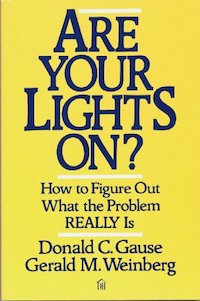Book Notes – Are Your Lights On?

Chapter 1. A Problem
Who has a problem?
ask WHAT.
Chapter 3. What’s Your Problem?
A problem is a difference between things as desired and things as perceived.
Don’t bother trying to solve problems for people who don’t have a sense of humor.
Chapter 4. Billy Brighteyes bests the bidders.
He had completely solved the problem in less than 5 minutes; How did billy solve it?
Don’t take their solution method for a problem definition
If you solve their problem too readily, they’ll never believe you’ve solved their real problem.
Moral issues tend to melt in the heat of a juicy problem to solve.
Chapter 5. Billy bites his tongue
Don’t mistake a solution method for a problem definition—especially if it’s your own solution method.
Chapter 6. Billy Back to the Bidders
You can never be sure you have a correct definition, even after the problem is solved
Don’t leap to conclusions, but don’t ignore your first impression.
What is the problem?
You can never be sure you have a correct definition, but don’t ever stop trying to get one.
Chapter 7. The endless chain
Each solution is the source of the next problem
The trickiest part of certain problems is just recognizing their existence.
If you can’t think of at least three things that might be wrong with your understanding of the problem, you don’t understand the problem.
Chapter 8. Missing the misfit
Designers, like landlords, seldom if ever experience the consequences of their actions.
Test your definition on a foreigner, someone blind, or a child, or make yourself foreign, blind, or childlike.
Each new point of view will produce a new misfit.
Chapter 9. Landing on the level
How could we change the problem statement to make the solution different?
What am i solving?
As you wander along the weary path of problem definition, check back home once in a while to see if you haven’t lost your way.
Chapter 10. Mind your meaning.
Once you have a problem statement in words, play with the words until the statement is in everyone’s head.
Chapter 11. Smoke gets in your eyes
Don’t solve other people’s problems when they can solve them perfectly well themselves.
If it’s their problem, make it their problem.
Chapter 12. The campus that was all spaced out
If a person is in a position to do something about a problem, but doesn’t have the problem, then do something so he does.
Try blaming yourself for a change—even for a moment.
Chapter 13. The lights at the end of the tunnel
If people really have their lights on, a little reminder may be more effective than your complicated solution.
Chapter 16. Make-works and take-credits
In the valley of the problem solvers, the problem creator is king, or president, or dean.
Chapter 17. Examinations and other puzzles
Where does the problem come from?
Chapter 18. Tom Tireless tinkers with toys.
In spite of appearances, people seldom know what they want until you give them what they ask for.
Chapter 19. Patience plays politics.
Not too many people. in the final analysis, really want their problems solved.
Chapter 20. A priority assignment
Do I really want a solution?
We never have enough time to do it right, but we always have enough time to do it over.
We never have enough time to consider whether we want it, but we always have enough time to regret it.
When we contemplate problems, items to which we are habituated tend to be omitted from consideration.